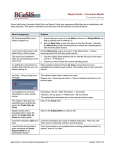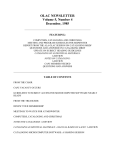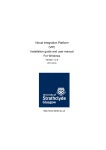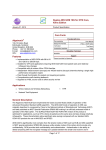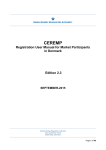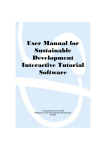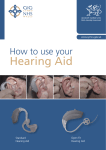Download CoA Manual Part 2 - Radium (May 2015)
Transcript
Guidance for Co-ordinators of Adjustments Part 2: Radium User Manual Updated May 2015 Draft 0.1 Student Disability Service The University of Edinburgh Third Floor The Main Library Building George Square Edinburgh EH8 9LJ 0131 650 6828 [email protected] www.ed.ac.uk/student-disability-service If you require this document in an alternative format please contact the Student Disability Service on 0131 650 6828 or [email protected] Guidance for Co-ordinators of Adjustments Part 2: Radium User Manual 2 Contents Introduction ......................................................................................................................................... 5 Main Radium functions ................................................................................................................ 5 Radium tasks for CoAs ................................................................................................................. 5 Login details ......................................................................................................................................... 5 Important contacts .............................................................................................................................. 5 Main Screen ......................................................................................................................................... 6 Main screen - Summary ............................................................................................................... 6 Student lists........................................................................................................................................ 10 Student overview screen ................................................................................................................... 11 Student, course and impairment information ........................................................................... 11 Generating a schedule ....................................................................................................................... 12 Additional information in the Recommended Adjustments section ......................................... 14 Adjustment Schedule ......................................................................................................................... 15 ‘Agreed Schedules (not circulated)’ ................................................................................................... 15 Important schedule information................................................................................................ 17 Sending a schedule..................................................................................................................... 17 Agreed Schedules (circulated) ................................................................................................... 20 View History ............................................................................................................................... 20 Delete Schedule ......................................................................................................................... 20 Alerts sent from the Student Disability Service ................................................................................. 22 Alerts sent from the Radium system ................................................................................................. 22 Automatic Alerts for Coordinators..................................................................................................... 22 My Settings......................................................................................................................................... 23 Email settings ............................................................................................................................. 23 Visual settings ............................................................................................................................ 23 Appendix 1 – Terminology Guide....................................................................................................... 24 Key people and services ............................................................................................................. 25 Appendix 2 - FAQ ............................................................................................................................... 26 This guidance should be read in conjunction with the Implementing Support for Disabled Students Guidance, August 2012 Guidance for Co-ordinators of Adjustments Part 2: Radium User Manual 3 The Student Disability Service Our vision: Challenging attitudes. Mainstreaming equality. Our mission: Supporting students with impairments to fulfil their academic potential. Working with academics and other University colleagues to support them to create an accessible learning and teaching environment. Guidance for Co-ordinators of Adjustments Part 2: Radium User Manual 4 Introduction Radium is an application developed by the Student Disability Service (SDS) to enable Coordinators of Adjustments (CoAs) to manage adjustment schedules more effectively. Emails are sent out to CoAs from the Student Disability Service database system to alert them to new students or profile changes. Radium should be checked manually, by logging into the system, frequently - especially at the start of semester, to make sure that all students have a generated schedule of adjustments and that it has been sent to all course organisers and course secretaries. Main Radium functions Radium performs three main functions: 1) Shows Coordinators of Adjustments the recommended adjustments for students studying courses within their School. 2) Allows quick generation of an agreed adjustments schedule. 3) Sends the adjustments schedule to course organisers and course secretaries as listed on the University database (currently called EUCLID). Radium tasks for CoAs Radium allows CoAs to view a Learning Profile, sent from an Advisor in the Student Disability Service, for each student registered on a course with a particular School. There are 3 tasks the Coordinators need to perform. 1) Agree adjustments – The CoA views the Learning Profile and checks that they agree with all the recommended adjustments. 2) Generate Schedule - If the Coordinator agrees with all the adjustments they can generate the schedule of adjustments. This means the School is taking responsibility to implement these adjustments. 3) Send schedule - After the schedule has been generated it needs to be sent to all the course organisers and course secretaries. Once the generated schedule has been sent out, the work for this student has been completed. This may need to be repeated if the course information or the adjustments change for the student. Login details The current web address to access Radium is: www.apps.disability-office.ed.ac.uk/radium Login using your EASE password. Important contacts Adjustment issues – [email protected] Individual student issues – [email protected] Adding or removing a Radium user – [email protected] Radium unavailable, technical problems – [email protected] Guidance for Co-ordinators of Adjustments Part 2: Radium User Manual 5 Main Screen This is the main or home screen in Radium. Main screen - Summary The home page shows a summary of each section. The students move through the sections until they are in the bottom list and no further action is required. The exceptions to this are Registry and Library users – it is sufficient to get students to the third list, since there are no course people in these departments to circulate the information to. Library and Registry users should generate the schedules but not (re)send schedules. Each line in the summary corresponds to an item in the Schedules/Adjustments menu: Guidance for Co-ordinators of Adjustments Part 2: Radium User Manual 6 Students move through the 4 sections as the tasks are completed by the Coordinator of Adjustments. Students can move back to other sections and will need action taken if: 1. The courses they are registered on in the University database (EUCLID) changes. 2. The student’s Learning Profile is changed by the Student Disability Service and sent out to the Coordinator again. Guidance for Co-ordinators of Adjustments Part 2: Radium User Manual 7 Section one: New Learning Profiles The ‘New Profiles’ section shows students who have recommended adjustments (a Learning Profile from the Student Disability Service) but who do not have agreed adjustments (an Adjustments Schedule) in your School. The CoA needs to check the adjustments and then generate a schedule to indicate the School agrees to implement these adjustments. Section two – Updated Learning Profiles The ‘Updated Profiles’ section shows students who have an updated profile (i.e. previously had an adjustment schedule) but who do not have up-to-date agreed adjustments (an upto-date Adjustments Schedule) in your school. The CoA needs to generate the schedule to indicate the school agrees to implement these adjustments. Section three – Agreed Schedules (not circulated) These schedules have been generated but have yet to be circulated to all the relevant course people. It is sufficient for Registry and Library users to get students to this point. Section four – Agreed Schedules (circulated) Guidance for Co-ordinators of Adjustments Part 2: Radium User Manual 8 The agreed schedules have been circulated for all students. All the CoA’s tasks have been completed at this stage. The aim is to only have students in the fourth, Agreed Schedules (circulated) list as this means all students have an adjustment schedule which has been fully circulated. Note that Library/Registry only need to get students to the Agreed Schedules (not circulated) list. Mainstreamed Adjustments The last menu item will list current mainstreamed adjustments, listing the provisions that have been agreed will apply to all students. Guidance for Co-ordinators of Adjustments Part 2: Radium User Manual 9 Student lists 1) Lists of students will appear in the different sections depending on where they are in the process. Click on next to a student to view their information. The fields shown are Surname, Forename, Matric No, Instance, UG/PG, Course Registered and Multiple Schedules. Guidance for Co-ordinators of Adjustments Part 2: Radium User Manual 10 Student overview screen Student, course and impairment information • Student Information - The first part shows some general information about their programme and Personal Tutor or Postgraduate supervisors. • Course Information - The courses the student is currently registered on in the University database (EUCLID) for this particular School. • Impairment Detail - There may be some specific information about the student’s disability in the Impairment Details section but this is optional for the Advisor and the student may not wish this information to be shared. Guidance for Co-ordinators of Adjustments Part 2: Radium User Manual 11 Generating a schedule 1) The Active Profiles / Recommended Adjustments section shows the adjustments recommended by the Student Disability Service. This is where the schedules are generated. • The tick indicates that the adjustment is relevant to your School, the Library or Registry. • The ‘New’ indicator means that the adjustment is not currently in a schedule generated by your School. This means you need to generate the schedule. • The button to generate the schedule is at the bottom of the recommended adjustment list. 2) Each adjustment will have a checkbox before it. Most adjustments will be ticked by default and this means that it is relevant to your School, the Library Service or Registry. Leaving the box ticked means that it will be included in the schedule. Guidance for Co-ordinators of Adjustments Part 2: Radium User Manual 12 3) The Recommended Adjustments section will have a list of adjustments. In this example we can see two adjustments. • One adjustment is in the ‘Teaching and Learning’ section and is ‘Provide either outline OR PowerPoint presentation for lecture/seminar at least 24 hours in advance’. • The second adjustment is in the ‘Examinations (including class tests)” section and is ‘Provide student with a standard PC in exams and in-course assessment’. 4) IMPORTANT - If a Coordinator has concerns about an adjustment they should first discuss this with the Student Disability Service Advisor to see if an equivalent acceptable adjustment can be recommended. Unticking an adjustment means that the School does not agree to implement this adjustment. You should contact the Student Disability Service before you untick an adjustment. 5) A Coordinator can name the schedule (remember that other Schools will be able to see your schedule names) and add additional comments. The additional remarks are included in the emails sent to course organisers and course secretaries by default but this can be unticked in the email options before the emails are sent. 6) If the Coordinator agrees the School will implement these adjustments they can generate the schedule using the ‘Generate Schedule’ button. Clicking the ‘Generate Schedule’ button will take the selected adjustments and copy them into the Adjustments Schedule section. Guidance for Co-ordinators of Adjustments Part 2: Radium User Manual 13 Additional information in the Recommended Adjustments section 1) Hover the mouse over the letters inside the square brackets to get additional information about the adjustment. Letter Text C Course related adjustment E Exam related adjustment T Non-registry related examination (class tests) 2) The info link gives more information about the adjustment. Additional Information Explanation Unique Recommended This is a unique ID code that identifies this adjustment Adjustment Identifier for the student. Adjustment Code This is the database code number for the adjustment. Adjustment Description Adjustment text Adjustment URL Some adjustments have a link to additional information. Date created Date the adjustment was added to the student’s profile. Created by Not currently used If you need more information about a particular adjustment please contact the Student Disability Service. Guidance for Co-ordinators of Adjustments Part 2: Radium User Manual 14 Adjustment Schedule Once you have generated some schedules the students will be listed under the ‘Agreed Schedules (not circulated)’ section. This means that the schedule has been generated but not sent to the course organisers and course secretaries for ALL the courses the student is registered on for your School. It is possible that the student has registered for courses after you first sent the schedule. In this case you will need to send the schedule to those course organisers and course secretaries who are yet to receive the schedule. Schedules created by other Schools, Registry or the Library for the same student are also shown for your reference. You can’t send or delete another School’s schedule – only the ones your School have generated. If you or your School have generated more than one schedule you need to make sure that the schedule you send out is the one with the highest version number. ‘Agreed Schedules (not circulated)’ 1) Once a schedule has been generated it needs to be sent to the course organisers and course secretaries. 2) Go through each student on the list. 3) Open the student’s overview screen by clicking ‘view profile’. 4) Scroll down to the Active Schedules / Agreed Adjustments section. Scroll down to the schedule that has been generated by your School. Guidance for Co-ordinators of Adjustments Part 2: Radium User Manual 15 5) A generated schedule needs to be sent to all the course organisers and course secretaries for each course. Guidance for Co-ordinators of Adjustments Part 2: Radium User Manual 16 Important schedule information The header section of the generated schedule holds some important information. 1) Each schedule can be given a unique name by the School generating it. You need to add the name before generating the schedule. This name can be seen by other Schools. 2) Each profile in the Active Profiles / Recommend Adjustments section has a version number indicating the number of times it has been changed and sent by the Student Disability Service . The schedule that you use to send out the current emails to course organisers and course secretaries must match this profile version. 3) The date that the schedule was generated by the Coordinator of Adjustments in the School is shown in the header section. Sending a schedule 1) Click on the ‘(Re)send Schedule’ link. 2) Select the correct email options. Guidance for Co-ordinators of Adjustments Part 2: Radium User Manual 17 3) Most Schools email both the Course Organiser and Course Secretary and this option needs to be changed from the drop down list next to each of the courses. 4) Recipients, such as the student and personal tutor, who have not received the schedule in the past will be ticked already. 5) Adjustments are always included in the schedule; you can also choose whether to include information on impairment. 6) If you added additional remarks before generating the schedule, you can include or remove these here. 7) Information on other support resources is no longer used and can always be left blank. Guidance for Co-ordinators of Adjustments Part 2: Radium User Manual 18 8) After selecting the recipients, click on ‘Show Email Preview’ button, this will show the email about to be sent. 9) A default header, footer and signature is added, which you can modify in My Settings. You may modify the email at this stage (please note a copy is retained for future reference). 10) Click on ‘Send Email’ button to send the emails. 11) Clicking Send will: a. send the email to the recipients. b. store the email for reference. c. update the sent status against each recipient and the schedule. 12) The student should now move into the final section ‘Has Sent Schedule’. Guidance for Co-ordinators of Adjustments Part 2: Radium User Manual 19 Agreed Schedules (circulated) The students in this list have a generated schedule and it has been emailed to all the relevant Course organisers and course secretaries. The aim is to only have students in the fourth list Agreed Schedules (circulated) as this means all students have an adjustments schedule which has been fully circulated. Note that Registry/Library users only need to get students as far as the Agreed Schedules (not circulated) list. View History This allows you to see a list of people the schedule has been sent to in the past (course organisers, course secretaries, supervisors, etc.). It relates directly to this schedule only, so if a revised schedule is created and sent you will need to view that history for the latest information. Delete Schedule Schedules can be deleted if any mistakes have been made or if you have more than one schedule. Schedules should be deleted when they are no longer applicable and/or being superseded by a new version. The Student Disability Service retains all schedules, including deleted ones, so these can be retrieved if needed. Guidance for Co-ordinators of Adjustments Part 2: Radium User Manual 20 1) Clicking Delete Schedule will then ask you to confirm deletion. Action A mistake has been made so a schedule is deleted. Problems that can occur Student will move back to the no adjustment schedule section and the schedule will need to be generated and sent again. There are duplicate schedules which are You delete all the schedules. You need to then deleted. keep at least one schedule. This schedule profile version should match the profile version of the profile in the Active Profiles / Recommended Adjustments section. When you delete a schedule it will remove the history from Radium. Having lots of duplicate schedules can be confusing so you need to make practical decisions sometimes about whether to keep an old profile for its history or delete it to keep Radium tidy. Guidance for Co-ordinators of Adjustments Part 2: Radium User Manual 21 Alerts sent from the Student Disability Service • • • Learning Profiles are created by the Student Disability Service following discussion between the student and their Advisor. Each time a profile is created or modified, an email will be sent to the relevant Coordinators. The email will advise that a Profile requires further action, and provide a web link to the student's record in Radium. The email contains no student information. Alerts sent from the Radium system • • When a Schedule is sent, the recipients an email containing the adjustments, support resources and so on. The recipients do not receive a link since they do not have access to the Radium system. Automatic Alerts for Coordinators • • • • When a student leaves a course, the Coordinator can be alerted automatically so that adjustments do not continue to apply. This option needs to be activated in the ‘My Settings’ section. If this is activated when a student joins a course, the CoA is alerted and advised that they should check the schedule is still suitable on this course, and send it to the new course team. This is not ticked as default as it can result in a large volume of emails being sent, especially at the beginning of the semester as students change courses more frequently. Guidance for Co-ordinators of Adjustments Part 2: Radium User Manual 22 My Settings • • On this screen you can change data which relates to you personally. Please note that if you share the role of CoA, each person should update their settings if there is common information to be used. Email settings General alert email settings are: Send me emails when students register on new courses? When students join new courses emails will be sent alerting you. This can cause a large volume of emails to be sent at certain times of the year. Settings available for emails sent to course organiser and course secretaries are: Include me in the Cc: field for schedule emails? Introductory text Concluding text Signature. Telephone number This automatically sends you an email when the emails are sent out to course organisers and course secretaries. Some CoAs use this as a way of archiving all emails they are responsible for sending from Radium as an audit trail. The greeting and header of the email, prior to the adjustment list. Text used after the system generated information Your signature/contact details. Not currently used. Visual settings The changes you can make to Radium visually are very limited although you can change the : • Preferred Visual Style. • Preferred Font. If you need any help in viewing Radium please contact the Student Disability Service. Guidance for Co-ordinators of Adjustments Part 2: Radium User Manual 23 Appendix 1 – Terminology Guide Accessible Learning: A project being taken forward by a working group in the University of Edinburgh, which will promote a mainstreaming approach and provide guidance for academics on how to make all aspects of learning and teaching accessible. (Guidance will update and replace the Teachability materials, which were produced by Strathclyde University some time ago). Adjustment: A change that might be made to academic processes in order to alleviate barriers to participation in learning and teaching activities or assessments Adjustments schedule: Those agreed/decided adjustments which will be implemented in a particular School or support service for a disabled student Academic contact: The person with whom the disabled student discusses adjustments once he or she arrives at the University. This is usually the Personal Tutor (previously Director of Studies) for undergraduates, the Programme Director for taught postgraduates and the Principal Supervisor for research postgraduates. For convenience, in this document, the role is referred to as the Personal Tutor. Competence standard: The Equality Act defines a competence standard as an academic, medical, or other standard applied by or on behalf of an education provider for the purpose of determining whether or not a person has a particular level of competence or ability. For academic purposes, a competence standard is not subject to recommended adjustments, but the way that a student may demonstrate ability to meet the competence standard may be adjusted. Example 1: The requirement for students studying for a law degree to demonstrate a particular standard of knowledge of certain areas of law in order to gain their degree is a competence standard. Example 2: A requirement that a student completes a test in a certain time period in not a competence standard – unless the competence being tested is the ability to do something within a limited time period. Co-ordinator of Adjustments: The individual in each School who, with the delegated authority of the Head of School, decides the adjustments to be made to the academic processes in that School for a disabled student, and oversees their implementation through the Adjustments Schedule for that School. Kelso: Not a Borders town, but the database which Advisors in the Student Disability Service use to record a student’s learning profile and to send it electronically to all recipients. Kelso is also used to record any contact with the student or his/her academic or support services contacts which may impact on the student’s course of study. Learning Profile: A profile of the student’s disability together with a list of recommended adjustments and support resources such as IT equipment. Radium: The database used by Coordinators of Adjustments (and key staff in the Student Disability Service) to manage adjustment schedules effectively and oversee the implementation of adjustments for students. Reasonable adjustment: As outlined in the Equality Act, a reasonable adjustment is “an action that helps to alleviate a substantial disadvantage” and which the institution can Guidance for Co-ordinators of Adjustments Part 2: Radium User Manual 24 “reasonably” be expected to implement. Reasonableness is not defined in the legislation, but the Equality and Human Rights Commission note that what is reasonable in each case will depend on the individual and suggests that the following factors can legitimately be considered – “all the individual circumstances of the case, including the importance of the service, the financial or other resources of the institution and the practicality of the adjustment. Other issues, such as the need to maintain academic standards, health and safety and the relevant interests of other people including other students are also important” Recommended Adjustment: An adjustment that the Student Disability Service has recommended be implemented to accommodate the student’s requirements. Teachability: A project and series of guidance booklets produced in 2004-05 by the University of Strathclyde and funded by the Scottish Funding Council. The guidance covered areas including “Creating accessible lectures for disabled students” and “Creating accessible examinations and assessments for disabled students”. Some Schools in the University of Edinburgh have Teachability Coordinators and carry out Teachability audits. The guidance is being updated by the University of Edinburgh at the time of writing, but can be viewed at: www.teachability.strath.ac.uk/ Key people and services Student: in this context, a disabled student, as defined by the Equality Act 2010. The Equality Act says that someone has a disability if they have a physical or mental impairment which has a long term or substantial adverse effect on their ability to carry out normal day to day activities. Physical or mental impairment includes sensory impairment such as those affecting sight or hearing. Impairments covered by the Act also include dyslexia, long term health conditions such as diabetes, cancer or HIV Personal Tutor (PT). The student’s academic contact (in some Schools this may be the Student Support Officer or, for postgraduate students the Supervisor or Programme Director Coordinator of Adjustments (CoA). The individual in each School who, with the delegated authority of the Head of School, decides the adjustments to be made to the academic process, and oversees the implementation of adjustments. Student Disability Service (SDS). The service which will meet with most disabled students to discuss their needs (if necessary in conjunction with the student’s academic contact), compile and distribute a Learning Profile, help those eligible to apply for Disabled Students Allowance, and match students with Student Support Assistants (note takers etc.) as required. Student Support Officers (SSOs): CoAs may designate additional academic delegates or administrative support, often Student Support Officers, to receive and act on Learning Profiles on their behalf. Whilst it is helpful to have an academic contact involved, the decision on who should take forward the process of implementing academic adjustments is one for each School. Guidance for Co-ordinators of Adjustments Part 2: Radium User Manual 25 Appendix 2 - FAQ 1) Why do I need to send out schedules for some of the same students every year? a. This is normally because schedules need to be sent out every year because a student’s courses change and therefore it’s possible that the course organiser and course secretary have changed. 2) I have a student in my list which says ‘(updated)’ but when I look at the recommended adjustments none of them say ‘New’. a. This can happen when an adjustment is removed or a single adjustment is added which is not considered to be your Schools responsibility e.g. an adjustment that is just for the Library. Unfortunately the system is not sophisticated enough to pick this up. The easiest thing to do is to generate the schedule and sent it out again. Guidance for Co-ordinators of Adjustments Part 2: Radium User Manual 26


























